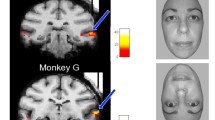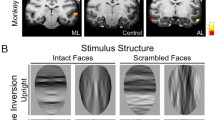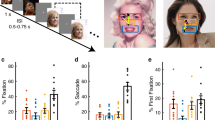Summary
Neurophysiological studies have shown that some neurons in the cortex in the superior temporal sulcus and in the inferior temporal cortex respond to faces. To determine if some face responsive neurons encode stimuli in an object-centered coordinate system rather than a viewer-centered coordinate system, a large number of neurons were tested for sensitivity to head movement in 3 macaque monkeys. Ten neurons responded only when a head undergoing rotatory movements was shown. All of these responded to a particular movement independently of the orientation of the moving head in relation to the viewer, maintaining specificity even when the moving head was inverted or shown from the back, thereby reversing viewer-centered movement vectors. This was taken as evidence that the movement was encoded in object-centered coordinates. In tests of whether there are neurons in this area which respond differently to the faces of different individuals relatively independently of viewing angle, it was found that a further 18 neurons responded more to one static face than another across different views. However, for 16 of these 18 cells there was still some modulation of the neuronal response with viewing angle. These 16 neurons thus did not respond perfectly in relation to the object shown independently of viewing angle, and may represent an intermediate stage between a viewercentered and an object-centered representation. In the same area as these neurons, other cells were found which responded on the basis of viewercentered coordinates. These neurophysiological findings provide evidence that some neurons in the inferior temporal visual cortex respond to faces (or heads) on the basis of object-centered coordinates, and that others have responses which are intermediate between object-centered and viewer-centered representations. The results are consistent with the hypothesis that object-centered representations are built in the inferior temporal visual cortex.
Similar content being viewed by others
References
Aggleton JP, Passingham RE (1981) Stereotaxic surgery under Xray guidance in the rhesus monkey, with special reference to the amygdala. Exp Brain Res 44: 271–276
Baylis GC, Rolls ET, Leonard CM (1985) Selectivity between faces in the responses of a population of neurons in the cortex in the superior temporal sulcus of the monkey. Brain Res 342: 91–102
Baylis GC, Rolls ET, Leonard CM (1987) Functional subdivisions of temporal lobe neocortex. J Neurosci 7: 330–342
Benton AL, Van Allen MW (1968) Impairment in facial recognition in patients with cerebral disease. Cortex 4: 344–358
Benton AL, Van Allen MW (1972) Prosopagnosia and facial discrimination. J Neurol Sci 15: 167–172
Bruce C, Desimone R, Gross CG (1981) Visual properties of neurons in a polysensory area in superior temporal sulcus of the macaque. J Neurophysiol 46: 369–384
DeRenzi E, Faglioni P, Spinnler H (1968) The performance of patients with unilateral brain damage on facial recognition tasks. Cortex 4: 17–34
Desimone R, Albright TD, Gross CG, Bruce C (1984) Stimulus selective properties of inferior temporal neurons in the macaque. J Neurosci 4: 2051–2062
Gross CG, Desimone R, Albright TD, Schwartz EL (1985) Inferior temporal cortex and pattern recognition. Exp Brain Res [Suppl 11]: 179–201
Hasselmo ME, Rolls ET, Baylis GC (1986) Selectivity between facial expressions in the responses of a population of neurons in the superior temporal sulcus of the monkey. Neurosci Lett [Suppl] 26: S571
Hasselmo ME, Rolls ET, Baylis GC (1989) The role of expression and identity in the face-selective responses of neurons in the temporal visual cortex of the monkey. Behav Brain Res (in press)
Horel JA (1984) Cold lesions in inferotemporal cortex produce reversible deficits in learning and retention of visual discriminations. Physiol Psychol 12: 259–270
Humphrey NK, Weiskrantz L (1969) Size constancy in monkeys with inferotemporal lesions. Q J Exp Psychol 21: 225–238
Jeeves MA, Milner AD, Perrett DI, Smith PAJ (1983) Visual cells responsive to direction of movement and stimulus form in the anterior superior temporal sulcus of the macaque monkey. J Physiol (Lond) 341: 80P
Malone DR, Morris HH, Kay MC, Levin HS (1982) Prosopagnosia: a double dissociation between the recognition of familiar and unfamiliar faces. J Neurol Neurosurg Psychiatry 45: 820–822
Marr D, Nishihara HK (1978) Representation and recognition of the spatial organization of three-dimensional shapes. Proc R Soc Lond [Biol] 200: 269–294
Merrill EG, Ainsworth A (1972) Glass-coated platinum-plated tungsten microelectrodes. Med Biol Eng 10: 662–672
Mishkin M, Hall M (1955) Discrimination along a size continuum following ablation of the inferior temporal convexity in monkeys. J Comp Physiol Psychol 48: 97–101
Perrett DI, Rolls ET, Caan W (1982) Visual neurons responsive to faces in the monkey temporal cortex. Exp Brain Res 47: 329–342
Perrett DI, Smith PAJ, Potter DD, Mistlin AJ, Head AS, Milner AD, Jeeves MA (1984) Neurones responsive to faces in the temporal cortex: studies of functional organization, sensitivity to identity and relation to perception. Hum Neurobiol 3: 197–208
Perrett DI, Smith PAJ, Mistlin AJ, Chitty AJ, Head AS, Potter DD, Broennimann R, Milner AD, Jeeves MA (1985a) Visual analysis of body movements by neurons in the temporal cortex of the macaque monkey: preliminary report. Behav Brain Res 16: 153–170
Perrett DI, Smith PAJ, Potter DD, Mistlin AJ, Head AS, Milner AD, Jeeves MA (1985b) Visual cells in the temporal cortex sensitive to face view and gaze direction. Proc R Soc Lond [Biol] 223: 293–317
Perrett DI, Mistlin AJ, Chitty AJ (1987) Visual neurones responsive to faces. Trends Neurosci 10: 358–364
Ratcliff G, Newcombe F (1982) Object recognition: some deductions from the clinical evidence. In: Ellis AW (ed) Normality and pathology in cognitive function. Academic Press, London, pp 147–171
Redican WK (1975) Facial expressions in non-human primates. In: Rosenblum LA (ed) Primate behavior: developments in field and laboratory research, Vol 4. Academic Press, New York, pp 103–194
Rolls ET (1984) Neurons in the cortex of the temporal lobe and in the amygdala of the monkey with responses selective for faces. Hum Neurobiol 3: 209–222
Rolls ET (1987) Information representation, processing and storage in the brain: analysis at the single neuron level. In: Changeux J-P, Konishi M (eds) The neural and molecular bases of learning. Wiley, Chichester, pp 503–540
Rolls ET (1989a) Visual information processing in the primate temporal lobe. In: Imbert M (ed) Models of visual perception: from natural to artificial. Oxford University Press, Oxford
Rolls ET (1989b) Functions of neuronal networks in the hippocampus and neocortex in memory. In: Byrne JH, Berry WO (eds) Neural models of plasticity: theoretical and empirical approaches. Academic Press, New York, (in press)
Rolls ET, Baylis GC (1986) Size and contrast have only small effects on the responses to faces of neurons in the cortex in the superior temporal sulcus. Exp Brain Res 65: 38–48
Rolls ET, Burton MJ, Mora F (1976) Hypothalamic neuronal responses associated with the sight of food. Brain Res 111: 53–66
Rolls ET, Sanghera MK, Roper-Hall A (1979) The latency of activation of neurones in the lateral hypothalamus and substantia innominata during feeding in the monkey. Brain Res 164: 121–135
Rolls ET, Baylis GC, Leonard CM (1985) Role of low and high spatial frequencies in the face-selective responses of neurons in the cortex in the superior temporal sulcus. Vision Res 25: 1021–1035
Rolls ET, Baylis GC, Hasselmo ME (1987) The responses of neurons in the cortex in the superior temporal sulcus of the monkey to band-pass spatial frequency filtered faces. Vision Res 27: 311–326
Salzen EA (1981) Perception of emotion in faces. In: Davies G, Ellis H, Shephard J (eds) Perceiving and remembering faces. Academic Press, London, pp 105–131
Ungerleider LG, Ganz L, Pribram KH (1977) Size constancy in rhesus monkeys: effects of pulvinar prestriate and inferotemporal lesions. Exp Brain Res 27: 251–269
Warrington EK (1982) Neuropsychological studies of object recognition. Philos Trans R Soc Lond [Biol] 298: 15–33
Warrington EK, Taylor AM (1978) Two categorical stages of object recognition. Perception 7: 695–705
Weiskrantz L (1985) Introduction: categorization, cleverness and consciousness. Philos Trans R Soc Lond [Biol] 308: 3–19
Weiskrantz L, Saunders RC (1984) Impairments of visual object transforms in monkeys. Brain 107: 1033–1072
Author information
Authors and Affiliations
Rights and permissions
About this article
Cite this article
Hasselmo, M.E., Rolls, E.T., Baylis, G.C. et al. Object-centered encoding by face-selective neurons in the cortex in the superior temporal sulcus of the monkey. Exp Brain Res 75, 417–429 (1989). https://doi.org/10.1007/BF00247948
Received:
Accepted:
Issue Date:
DOI: https://doi.org/10.1007/BF00247948




